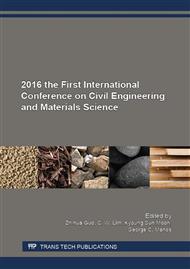p.31
p.37
p.43
p.49
p.53
p.58
p.63
p.68
p.73
Study of the Technical Capability of Sugarcane Bagasse Ash in Concrete Production
Abstract:
Cement industry has a great contribution to CO2 emissions in the world. In order to reduce the levels of CO2 emissions and the consequences of global warming, some researches have been developed aiming to reduce the cement volume produced through mineral mixtures. Sugarcane bagasse ash (SCBA) represents an important environmental liability of the alcohol industry in the northern state of Rio de Janeiro and its use as a partial replacement of Portland cement in concrete has shown great potential for use. This paper aims to analyze, through experimental procedures, the consistency and mechanic strength on concrete with low environmental impact, made from sugarcane bagasse ash, in substitution levels of 20% and 40%. The methodology of the experimental program, included the steps of characterizing the materials; definition of the reference concrete; molding and dosing of the reference concrete and concrete with SCBA; mechanical tests to evaluate the resistance in the reference test bodies; and analysis of the results. The method used from production and processing of the ash to the characterization of other materials in the concrete are also addressed in this study. The results indicate the feasibility of using sugarcane bagasse ashes in application of concretes in the construction industry.
Info:
Periodical:
Pages:
53-57
Citation:
Online since:
August 2016
Price:
Сopyright:
© 2016 Trans Tech Publications Ltd. All Rights Reserved
Share:
Citation:


